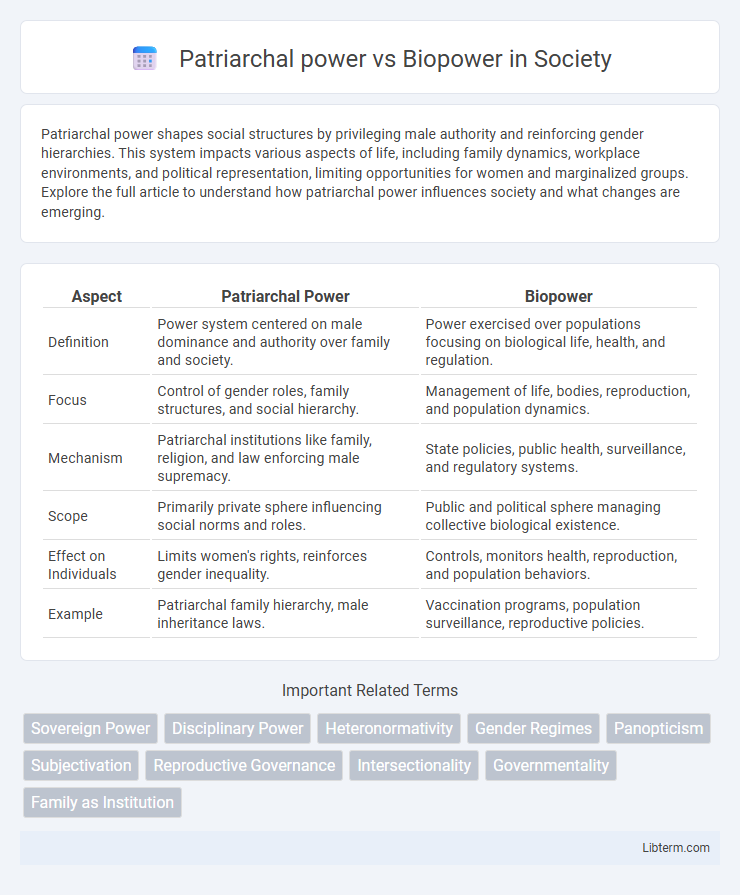Patriarchal power shapes social structures by privileging male authority and reinforcing gender hierarchies. This system impacts various aspects of life, including family dynamics, workplace environments, and political representation, limiting opportunities for women and marginalized groups. Explore the full article to understand how patriarchal power influences society and what changes are emerging.
Table of Comparison
| Aspect | Patriarchal Power | Biopower |
|---|---|---|
| Definition | Power system centered on male dominance and authority over family and society. | Power exercised over populations focusing on biological life, health, and regulation. |
| Focus | Control of gender roles, family structures, and social hierarchy. | Management of life, bodies, reproduction, and population dynamics. |
| Mechanism | Patriarchal institutions like family, religion, and law enforcing male supremacy. | State policies, public health, surveillance, and regulatory systems. |
| Scope | Primarily private sphere influencing social norms and roles. | Public and political sphere managing collective biological existence. |
| Effect on Individuals | Limits women's rights, reinforces gender inequality. | Controls, monitors health, reproduction, and population behaviors. |
| Example | Patriarchal family hierarchy, male inheritance laws. | Vaccination programs, population surveillance, reproductive policies. |
Understanding Patriarchal Power: Historical Roots
Patriarchal power originates from historical social structures where male authority dominated familial, political, and economic systems, deeply embedding gender hierarchies in cultural norms. This form of power enforces control through kinship, inheritance laws, and religious doctrines, shaping societal expectations and roles for women and men. Understanding these roots reveals the persistent influence of patriarchy in contemporary institutions and gender relations.
Defining Biopower: Foucault’s Influence
Biopower, a concept developed by Michel Foucault, refers to the regulation of populations through institutions, policies, and discourses that manage life, health, and bodies. Unlike patriarchal power, which centers on hierarchical, male-dominated authority and control over social and familial structures, biopower operates through diffuse mechanisms that target the biological processes of individuals and groups. Foucault's analysis highlights how modern states exert power not only through law and sovereignty but by orchestrating life itself via public health, surveillance, and social norms.
Key Differences Between Patriarchal Power and Biopower
Patriarchal power centers on the dominance of male authority in social structures, controlling gender roles, family dynamics, and institutional hierarchies. Biopower, a concept developed by Michel Foucault, emphasizes the regulation of populations through institutions, policies, and practices that manage life, health, and bodies. Key differences include patriarchal power's focus on gendered domination and authority, while biopower addresses broader mechanisms of population control and the administration of life processes.
Mechanisms of Control: Gender vs. Population
Patriarchal power operates through gendered mechanisms of control by enforcing norms, roles, and expectations that subordinate women and maintain male dominance within family and social structures. Biopower, as theorized by Michel Foucault, exerts control over populations by regulating birth rates, health, and life processes through institutions, public policies, and surveillance. While patriarchal power targets individual bodies based on gender to perpetuate hierarchies, biopower manages entire populations, deploying techniques such as demographic monitoring and public health campaigns to optimize life and productivity on a broader scale.
The Role of Institutions in Shaping Power Dynamics
Institutions such as the family, education systems, and legal frameworks play a crucial role in reinforcing patriarchal power by normalizing gender hierarchies and male dominance in social structures. Biopower operates through these same institutions by regulating populations via surveillance, health policies, and reproductive controls, shaping individuals' bodies and behaviors to serve state or societal objectives. The interplay between patriarchal power and biopower within institutions perpetuates systemic control by embedding gendered norms and disciplinary mechanisms that govern life and social order.
Intersectionality: Where Patriarchy and Biopower Meet
Patriarchal power and biopower intersect through the regulation and control of bodies, particularly within gendered and racialized contexts, highlighting the importance of intersectionality in analyzing these dynamics. Patriarchy enforces gender hierarchies and norms, while biopower manages populations through state mechanisms such as reproductive rights, health policies, and surveillance, disproportionately impacting marginalized groups. Intersectionality reveals how overlapping systems of oppression amplify the control exerted over bodies, shaping social inequalities and access to resources.
Impact on Bodies: Regulation, Surveillance, and Discipline
Patriarchal power exerts control over bodies through gender norms, enforcing roles and behaviors via social expectations, moral codes, and institutional practices that regulate women's reproductive functions and sexuality. Biopower operates by managing populations through mechanisms of surveillance, public health policies, and statistical regulation, targeting bodies to optimize life and control mortality rates. Both forms of power discipline bodies, but while patriarchal power emphasizes gendered subjugation, biopower prioritizes the management of biological life and population health.
Resistance Against Patriarchal Power and Biopower
Resistance against patriarchal power often involves feminist movements that challenge gender norms and advocate for equal rights, dismantling systemic inequalities embedded in social and political institutions. Against biopower, resistance manifests through activism focused on bodily autonomy, reproductive rights, and the critique of state control over populations, emphasizing individual and collective agency. Both forms of resistance employ strategies such as grassroots organizing, legal challenges, and consciousness-raising to contest domination and promote social justice.
Case Studies: Manifestations in Contemporary Society
Patriarchal power manifests through gender-based hierarchies and systemic inequalities evident in wage gaps and representation disparities across political and corporate sectors. Biopower operates by regulating populations via public health policies, surveillance technologies, and reproductive rights control, as seen in pandemic responses and biometric data collection. Case studies reveal how these powers intersect, amplifying social control mechanisms that disproportionately impact marginalized genders in healthcare access and legal systems.
Future Directions: Rethinking Power Structures
Future directions in rethinking power structures emphasize integrating insights from patriarchal power, which enforces gender hierarchies through social norms, with biopower, which regulates populations via institutions and surveillance. Emerging frameworks propose dismantling intersecting systems of control by addressing both bodily autonomy and socio-political governance to create more equitable societies. Advancements in critical theory and activism increasingly focus on decentralized models of power that prioritize collective agency and resist authoritarian biopolitical mechanisms.
Patriarchal power Infographic

 libterm.com
libterm.com